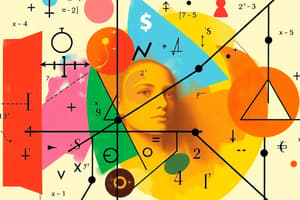Podcast
Questions and Answers
What does PEMDAS stand for in the order of operations?
What does PEMDAS stand for in the order of operations?
- Parentheses, Exponents, Multiplication, Division, Subtraction, Addition
- Parentheses, Exponents, Multiplication, Addition, Division, Subtraction
- Products, Exponents, Multiplication, Division, Addition, Subtraction
- Parentheses, Exponents, Multiplication, Division, Addition, Subtraction (correct)
Which of the following best describes a function in algebra?
Which of the following best describes a function in algebra?
- A mathematical statement that includes an equal sign
- A relation between a set of inputs and outputs (correct)
- A variable that represents a fixed number
- An equation that can never be solved
Which geometric theorem relates the lengths of the sides of a right triangle?
Which geometric theorem relates the lengths of the sides of a right triangle?
- Triangle inequality theorem
- Fundamental theorem of arithmetic
- Ptolemy's theorem
- Pythagorean theorem (correct)
What does the derivative measure in calculus?
What does the derivative measure in calculus?
Which of the following is a measure of central tendency?
Which of the following is a measure of central tendency?
What is a prime number?
What is a prime number?
Which branch of mathematics deals with counting, permutations, and combinations?
Which branch of mathematics deals with counting, permutations, and combinations?
Why is understanding mathematical concepts preferable to merely memorizing them?
Why is understanding mathematical concepts preferable to merely memorizing them?
Flashcards are hidden until you start studying
Study Notes
Key Areas of Mathematics
-
Arithmetic
- Basic operations: addition, subtraction, multiplication, division.
- Order of operations: PEMDAS (Parentheses, Exponents, Multiplication and Division, Addition and Subtraction).
-
Algebra
- Variables: symbols representing numbers or values.
- Equations: mathematical statements with an equal sign.
- Functions: relations between a set of inputs and outputs.
- Solving linear equations: isolate the variable.
-
Geometry
- Shapes: circles, triangles, squares, etc.
- Properties: area, perimeter, volume.
- Theorems: Pythagorean theorem, properties of angles (e.g., complementary, supplementary).
-
Trigonometry
- Functions: sine, cosine, tangent.
- Relationships: right triangles, unit circle.
- Applications: waves, oscillations, and circular motion.
-
Calculus
- Limits: foundational concept for continuity and derivatives.
- Derivatives: measure of change; slope of the tangent line.
- Integrals: accumulation of quantities; area under a curve.
- Fundamental theorem of calculus: links differentiation and integration.
-
Statistics
- Data types: qualitative vs. quantitative.
- Descriptive statistics: mean, median, mode, standard deviation.
- Probability: likelihood of an event occurring; basic rules (and, or).
-
Number Theory
- Prime numbers: numbers greater than 1 with no divisors other than 1 and themselves.
- Divisibility rules: rules for determining if a number can be divided by another number.
- Greatest common divisor (GCD) and least common multiple (LCM).
-
Discrete Mathematics
- Set theory: study of sets, operations on sets, Venn diagrams.
- Combinatorics: counting, permutations, combinations.
- Graph theory: study of graphs, vertices, and edges.
Study Tips
- Understand concepts rather than memorizing.
- Practice problems regularly to reinforce learning.
- Use visual aids (diagrams, graphs) for complex ideas.
- Relate mathematical concepts to real-world applications to enhance understanding.
Arithmetic
- Foundation of mathematics, involving basic operations.
- Addition, subtraction, multiplication, and division are the fundamental operations.
- Order of operations (PEMDAS) determines the sequence in which calculations are performed.
Algebra
- Extends arithmetic by introducing variables, which represent unknown numbers.
- Equations express relationships between variables and numbers, utilizing an equal sign.
- Functions establish relationships between inputs and outputs, providing a rule for transforming inputs.
- Solving linear equations aims to isolate the variable by using inverse operations.
Geometry
- Focuses on shapes, their properties, and relationships.
- Common shapes include circles, triangles, squares, and rectangles.
- Properties like area, perimeter, and volume quantify the size and dimensions of shapes.
- Theorems provide rules and relationships, like the Pythagorean theorem for right triangles.
Trigonometry
- Deals with relationships between angles and sides in triangles.
- Sine, cosine, and tangent are fundamental trigonometric functions.
- Applications include analyzing waves, oscillations, and circular motion.
Calculus
- Provides a framework for analyzing continuous change and accumulation.
- Limits are foundational, defining the behavior of functions as variables approach specific values.
- Derivatives measure the rate of change of a function, representing its instantaneous slope.
- Integrals calculate the accumulation of quantities, often represented as the area under a curve.
- The Fundamental Theorem of Calculus establishes a crucial connection between differentiation and integration.
Statistics
- Involves the collection, analysis, and interpretation of data.
- Qualitative and quantitative data are distinguished based on their nature.
- Descriptive statistics summarize data using measures like mean, median, mode, and standard deviation.
- Probability quantifies the likelihood of events occurring, applying rules like "and" and "or".
Number Theory
- Explores the properties of integers and their relationships.
- Prime numbers are central, having only two divisors: 1 and themselves.
- Divisibility rules offer shortcuts for determining if a number is divisible by another.
- Finding the greatest common divisor (GCD) and least common multiple (LCM) helps understand relationships between numbers.
Discrete Mathematics
- Deals with objects that can be counted and categorized.
- Set theory is a core concept, exploring sets, operations, and relationships using Venn diagrams.
- Combinatorics focuses on counting arrangements and selections, involving permutations and combinations.
- Graph theory studies networks represented by graphs (vertices and edges) to analyze relationships and flow.
Studying That Suits You
Use AI to generate personalized quizzes and flashcards to suit your learning preferences.




